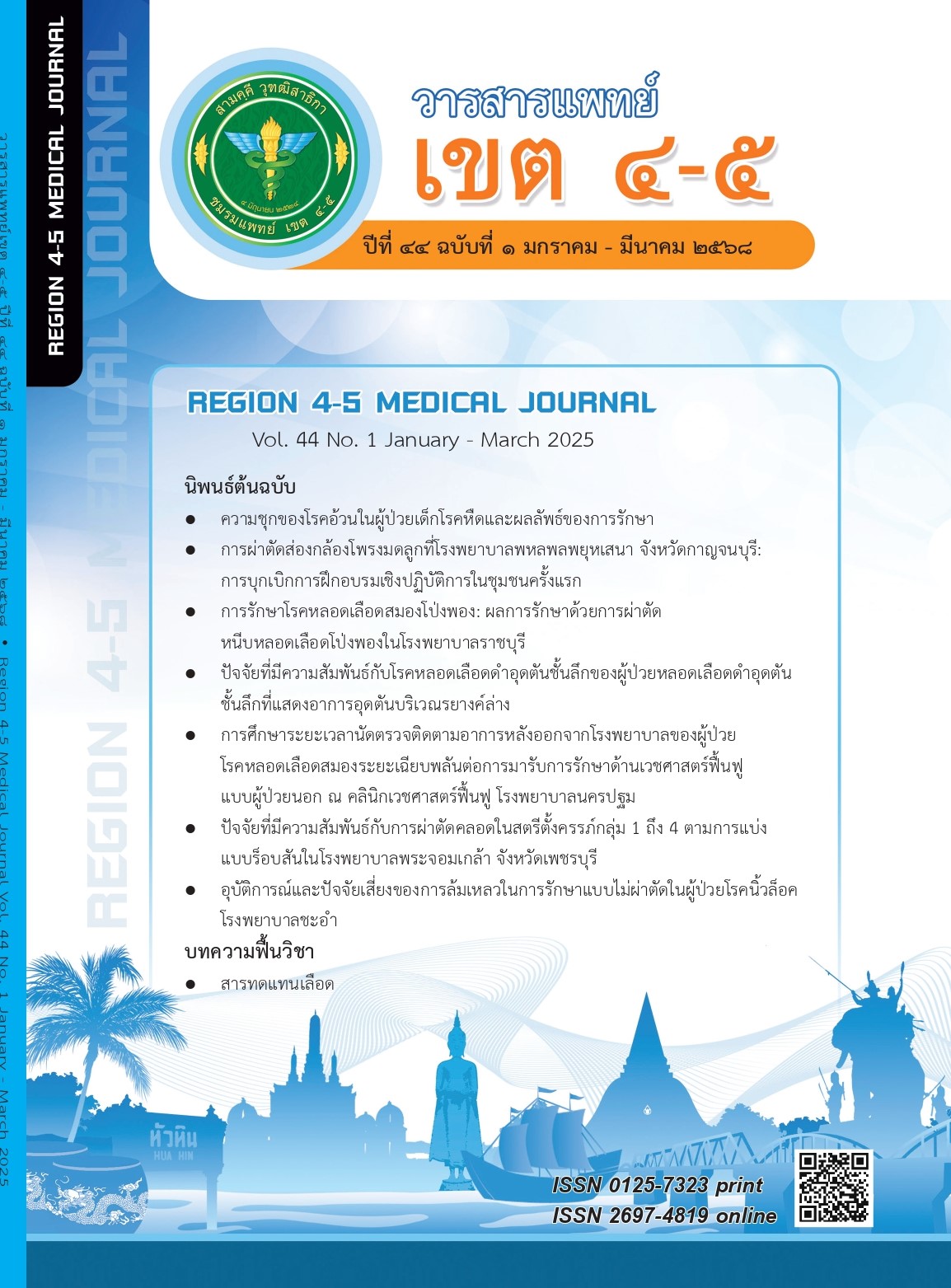เปรียบเทียบผลลัพธ์ของการตั้งครรภ์ระหว่างผู้ป่วยที่มีและไม่มีภาวะเบาหวานขณะตั้งครรภ์ในหญิงตั้งครรภ์ที่มีน้ำหนักเกินเกณฑ์และอ้วน
คำสำคัญ:
ภาวะอ้วน, ภาวะน้ำหนักเกินเกณฑ์, เบาหวานขณะตั้งครรภ์, ภาวะแทรกซ้อนของการตั้งครรภ์บทคัดย่อ
วัตถุประสงค์: เพื่อเปรียบเทียบผลลัพธ์ของการตั้งครรภ์ในหญิงตั้งครรภ์ที่มีภาวะน้ำหนักเกินเกณฑ์และอ้วน ระหว่างผู้ป่วยที่มีและไม่มีภาวะเบาหวานขณะตั้งครรภ์ และเพื่อศึกษาปัจจัยเสี่ยงต่อการเกิดโรคเบาหวานในหญิงตั้งครรภ์ที่มีภาวะน้ำหนักเกินเกณฑ์และอ้วน ในโรงพยาบาลพระจอมเกล้าจังหวัดเพชรบุรี
วิธีการศึกษา: การศึกษาเป็นแบบวิเคราะห์ย้อนหลัง โดยใช้ข้อมูลจากเวชระเบียนของหญิงที่คลอดบุตรที่โรงพยาบาลพระจอมเกล้า จังหวัดเพชรบุรี ระหว่างเดือนตุลาคม พ.ศ. 2566 ถึงเดือนพฤษภาคม พ.ศ. 2567 กลุ่มตัวอย่างประกอบด้วย หญิงตั้งครรภ์ที่มีภาวะน้ำหนักเกินเกณฑ์และอ้วน จำนวน 323 คน แบ่งเป็นกลุ่มที่มีภาวะเบาหวานขณะตั้งครรภ์ 67 คน (ร้อยละ 20.7) และกลุ่มที่ไม่มีภาวะเบาหวาน 256 คน (ร้อยละ 79.3)
ผลการศึกษา: พบความชุกของภาวะน้ำหนักเกินเกณฑ์และอ้วน ร้อยละ 33.3 โดยกลุ่มที่มีภาวะเบาหวานขณะตั้งครรภ์มีอายุเฉลี่ยมากกว่า มีดัชนีมวลกายก่อนตั้งครรภ์เฉลี่ยสูงกว่า และมีการเพิ่มขึ้นของน้ำหนักตัวระหว่างตั้งครรภ์ต่ำกว่าเกณฑ์มากกว่ากลุ่มที่ไม่เป็นเบาหวาน ผลลัพธ์ของการตั้งครรภ์พบหญิงตั้งครรภ์ที่มีภาวะเบาหวานขณะตั้งครรภ์มีอัตราการเกิดภาวะแทรกซ้อนสูงกว่า ได้แก่ ทารกมีน้ำตาลในเลือดต่ำ (ร้อยละ 14.9 เทียบกับ 3.5; p = .002) และทารกมีการบาดเจ็บจากการคลอด (ร้อยละ 9 เทียบกับ 2; p = .012) นอกจากนี้พบว่าหญิงตั้งครรภ์ที่มีภาวะน้ำหนักเกินเกณฑ์และอ้วนทั้งสองกลุ่มมีอัตราการผ่าคลอดที่สูงถึง ร้อยละ 63.8
สรุป: ภาวะเบาหวานขณะตั้งครรภ์ในหญิงที่มีภาวะน้ำหนักเกินและอ้วน เพิ่มความเสี่ยงต่อการเกิดภาวะทารกมีน้ำตาลในเลือดต่ำและทารกมีการบาดเจ็บขณะคลอด ดังนั้นควรให้ความสำคัญในการควบคุมน้ำหนักตัวก่อนตั้งครรภ์ รวมถึงการคัดกรองและการดูแลภาวะเบาหวานอย่างเหมาะสม
เอกสารอ้างอิง
World Health Organization. Obesity and overweight [internet]. 2021 [cited 2023 December 25]; Available from: URL: https://www.who.int/en/news-room/fact-sheets/detail/obesityand-overweight
World Health Organization. Prevalence of obesity among adults [internet]. 2022 [cited 2024 March 6]; Available from: URL: https://www.who.int/data/gho/data/indicators/indicator-details/GHO/prevalence-of-obesity-among-adults-bmi-=-30-(crude-estimate)-(-)
Hanprasertpong T. Overweight and obesity in pregnancy. TJOG 2020;28(1):2–5. doi: 10.14456/tjog.2020.1.
Rudtanasudjatum K, Chullapram T. The association between obesity and the risk of cesarean delivery and other adverse pregnancy outcomes in singleton term pregnancies. TJOG 2008;16(3):139–45.
Linder T, Eder A, Monod C, et al. Impact of prepregnancy overweight and obesity on treatment modality and pregnancy outcome in women with gestational diabetes mellitus. Front Endocrinol (Lausanne) 2022;13:799625. doi: 10.3389/fendo.2022.799625.
Kim SY, England L, Wilson HG, et al. Percentage of gestational diabetes mellitus attributable to overweight and obesity. Am J Public Health 2010;100(6):1047–52. doi: 10.2105/AJPH.2009.172890.
Jatavan P, Luewan S, Sirilert S, et al. Trends in the prevalence of diabetes mellitus in pregnancy during the past two decades in northern Thailand. Healthcare (Basel) 2023;11(9):1315. doi: 10.3390/healthcare11091315.
ACOG Practice Bulletin No. 190: Gestational Diabetes Mellitus. Obstet Gynecol 2018;131(2):e49–64. doi: 10.1097/AOG.0000000000002501.
de Carvalho LS, de Oliveira AAD, Grabovski TCM, et al. Maternal prepregnancy obesity and gestational diabetes influence on adverse perinatal outcomes. Arch Endocrinol Metab 2023;67(4):e000605. doi: 10.20945/2359-3997000000605.
Yang Z, Phung H, Freebairn L, et al. Contribution of maternal overweight and obesity to the occurrence of adverse pregnancy outcomes. Aust N Z J Obstet Gynaecol 2019;59(3):367–74. doi: 10.1111/ajo.12866.
Prasit K, Boriboonhirunsarn D. Prevalence of gestational diabetes diagnosed before 24 weeks of gestation. TJOG 2022;30(6):423–31. doi: 10.14456/tjog.2022.49
Kaewsrinual S, Boriboonhirunsarn D. Risk factors for insulin therapy in gestational diabetes mellitus. TJOG 2022;30:51–9. doi: 10.14456/tjog.2022.7
Rasmussen KM, Yaktine AL, editors. Weight gain during pregnancy: reexamining the guidelines. Washington, DC: The National Academies Press; 2009.
Cunningham FG, Leveno KJ, Dashe JS, et al. Williams Obstetric. 26th ed. New York: McGraw Hill; 2022.
Ngamjarus C, Pattanittum P. n4Studies: application for sample size calculation in health science research. Version 2.3. App store; 2024.
Bernard, R. Fundamentals of biostatistics. 5th ed. Duxbery: Thomson learning; 2000: 384–385.
Ngamjarus C. Sample size calculation for health science research. Khon Kaen, Thailand: Khon Kaen University Printing House; 2021.
Yang H, Xiao C, Tu J. The effect of gestational diabetes mellitus on pregnancy outcomes in advanced primiparous women: a retrospective study. Medicine (Baltimore) 2024;103(13):e37570. doi: 10.1097/MD.0000000000037570.
Wing RR, Caughey AB, Phelan S. Preconception weight loss to improve pregnancy outcomes: does the evidence justify national recommendations? Obesity (Silver Spring) 2023;31(3):594–6. doi: 10.1002/oby.23665.
Anekpornwattana S, Yangnoi J, Jareemit N, et al. Cesarean section rate in Siriraj hospital according to the Robson classification. TJOG 2020;28(1):6–15. doi.org/10.14456/tjog.2020.2
Voormolen DN, de Wit L, van Rijn BB, et al. Neonatal hypoglycemia following diet-controlled and insulin-treated gestational diabetes mellitus. Diabetes Care 2018;41(7):1385–90. doi: 10.2337/dc18-0048.
ดาวน์โหลด
เผยแพร่แล้ว
รูปแบบการอ้างอิง
ฉบับ
ประเภทบทความ
สัญญาอนุญาต

อนุญาตภายใต้เงื่อนไข Creative Commons Attribution-NonCommercial-NoDerivatives 4.0 International License.
ลิขสิทธิ์บทความเป็นของผู้เขียนบทความ แต่หากผลงานของท่านได้รับการพิจารณาตีพิมพ์ลงวารสารแพทย์เขต 4-5 จะคงไว้ซึ่งสิทธิ์ในการตีพิมพ์ครั้งแรกด้วยเหตุที่บทความจะปรากฎในวารสารที่เข้าถึงได้ จึงอนุญาตให้นำบทความในวารสารไปใช้ประโยชน์ได้ในเชิงวิชาการโดยจำเป็นต้องมีการอ้างอิงถึงชื่อวารสารอย่างถูกต้อง แต่ไม่อนุญาตให้นำไปใช้ในเชิงพาณิชย์




